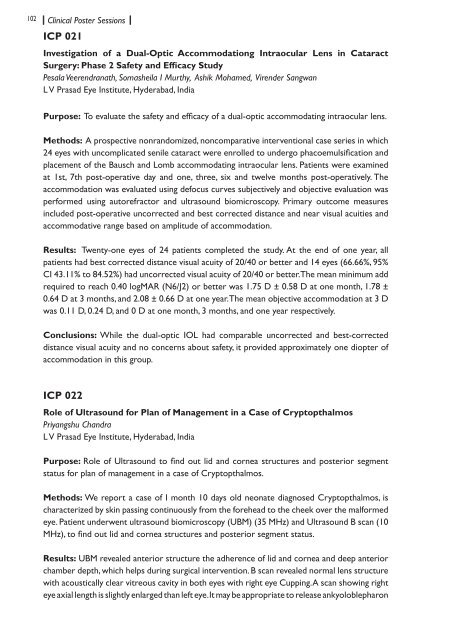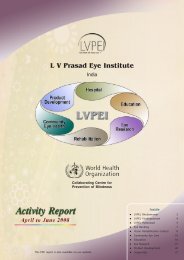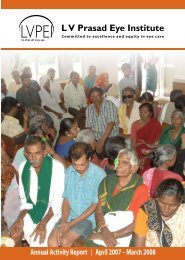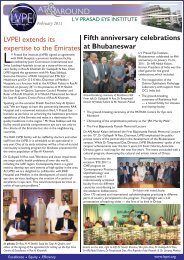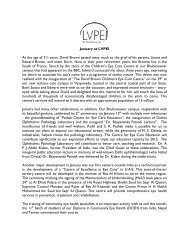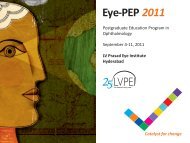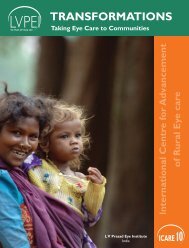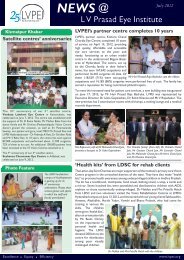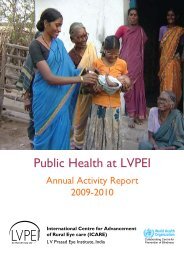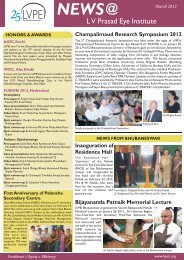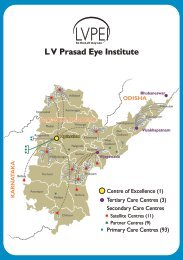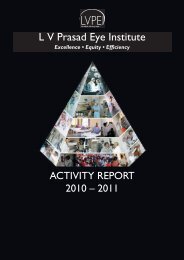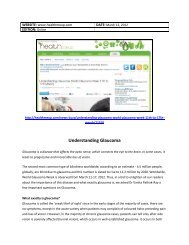IERG Abstracrt Book.indd - LV Prasad Eye Institute
IERG Abstracrt Book.indd - LV Prasad Eye Institute
IERG Abstracrt Book.indd - LV Prasad Eye Institute
Create successful ePaper yourself
Turn your PDF publications into a flip-book with our unique Google optimized e-Paper software.
102 Clinical Poster SessionsICP 021Investigation of a Dual-Optic Accommodationg Intraocular Lens in CataractSurgery: Phase 2 Safety and Efficacy StudyPesala Veerendranath, Somasheila I Murthy, Ashik Mohamed, Virender SangwanL V <strong>Prasad</strong> <strong>Eye</strong> <strong>Institute</strong>, Hyderabad, IndiaPurpose: To evaluate the safety and efficacy of a dual-optic accommodating intraocular lens.Methods: A prospective nonrandomized, noncomparative interventional case series in which24 eyes with uncomplicated senile cataract were enrolled to undergo phacoemulsification andplacement of the Bausch and Lomb accommodating intraocular lens. Patients were examinedat 1st, 7th post-operative day and one, three, six and twelve months post-operatively. Theaccommodation was evaluated using defocus curves subjectively and objective evaluation wasperformed using autorefractor and ultrasound biomicroscopy. Primary outcome measuresincluded post-operative uncorrected and best corrected distance and near visual acuities andaccommodative range based on amplitude of accommodation.Results: Twenty-one eyes of 24 patients completed the study. At the end of one year, allpatients had best corrected distance visual acuity of 20/40 or better and 14 eyes (66.66%, 95%CI 43.11% to 84.52%) had uncorrected visual acuity of 20/40 or better. The mean minimum addrequired to reach 0.40 logMAR (N6/J2) or better was 1.75 D ± 0.58 D at one month, 1.78 ±0.64 D at 3 months, and 2.08 ± 0.66 D at one year. The mean objective accommodation at 3 Dwas 0.11 D, 0.24 D, and 0 D at one month, 3 months, and one year respectively.Conclusions: While the dual-optic IOL had comparable uncorrected and best-correcteddistance visual acuity and no concerns about safety, it provided approximately one diopter ofaccommodation in this group.ICP 022Role of Ultrasound for Plan of Management in a Case of CryptopthalmosPriyangshu ChandraL V <strong>Prasad</strong> <strong>Eye</strong> <strong>Institute</strong>, Hyderabad, IndiaPurpose: Role of Ultrasound to find out lid and cornea structures and posterior segmentstatus for plan of management in a case of Cryptopthalmos.Methods: We report a case of I month 10 days old neonate diagnosed Cryptopthalmos, ischaracterized by skin passing continuously from the forehead to the cheek over the malformedeye. Patient underwent ultrasound biomicroscopy (UBM) (35 MHz) and Ultrasound B scan (10MHz), to find out lid and cornea structures and posterior segment status.Results: UBM revealed anterior structure the adherence of lid and cornea and deep anteriorchamber depth, which helps during surgical intervention. B scan revealed normal lens structurewith acoustically clear vitreous cavity in both eyes with right eye Cupping. A scan showing righteye axial length is slightly enlarged than left eye. It may be appropriate to release ankyoloblepharon


